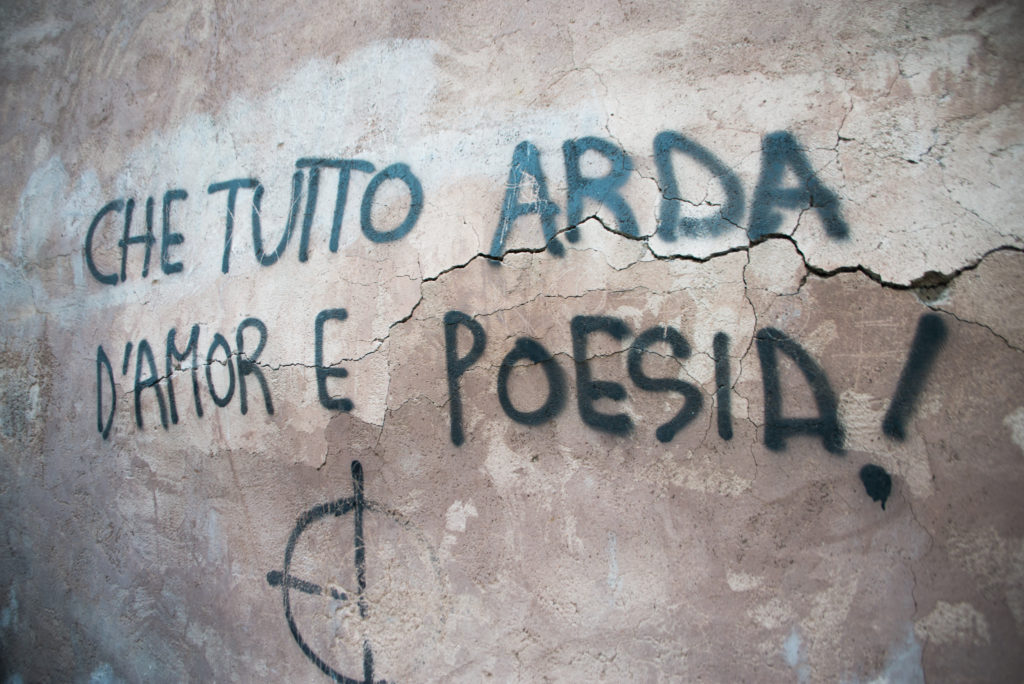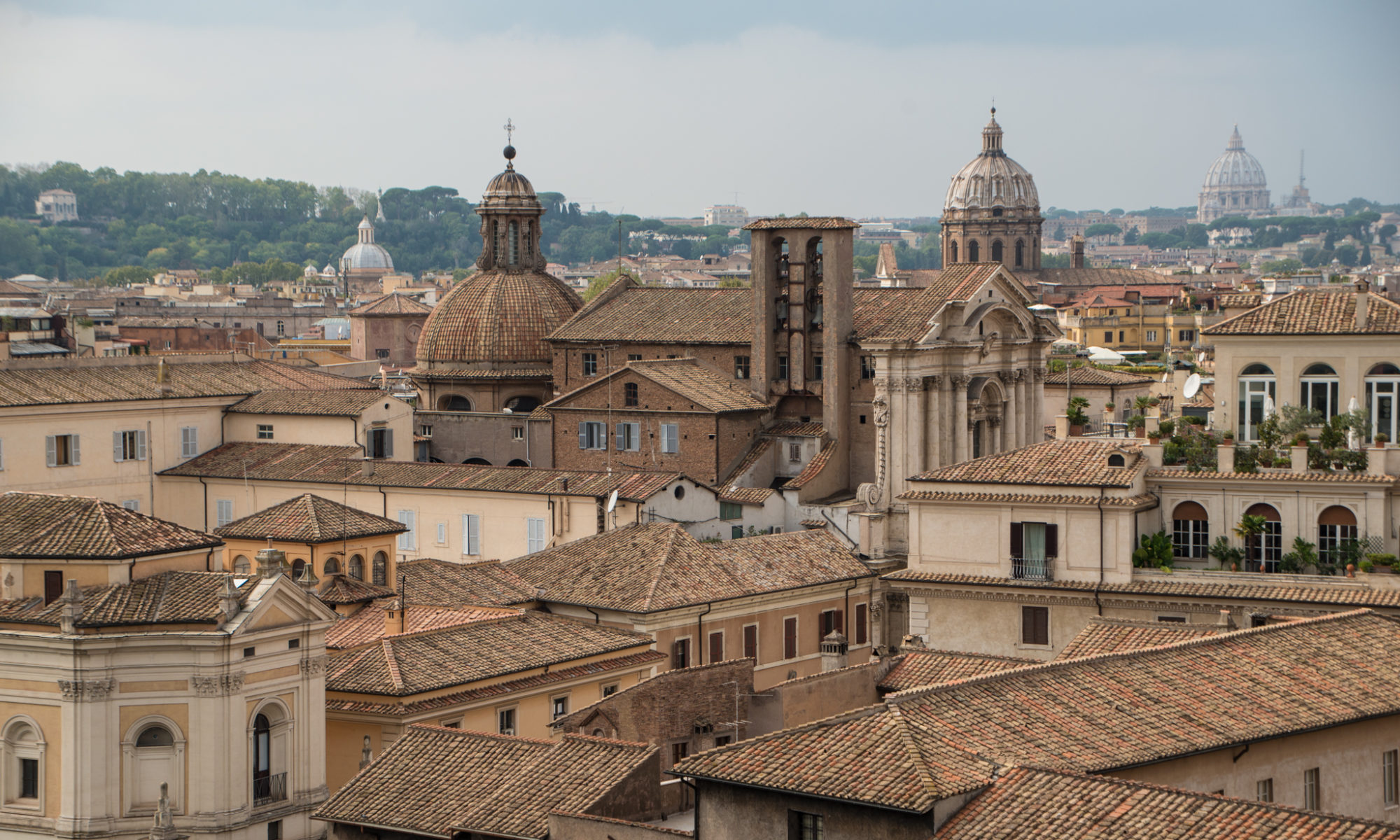Rome In Ecstasy: A Caravaggio Trip Into The Times Of Baroque
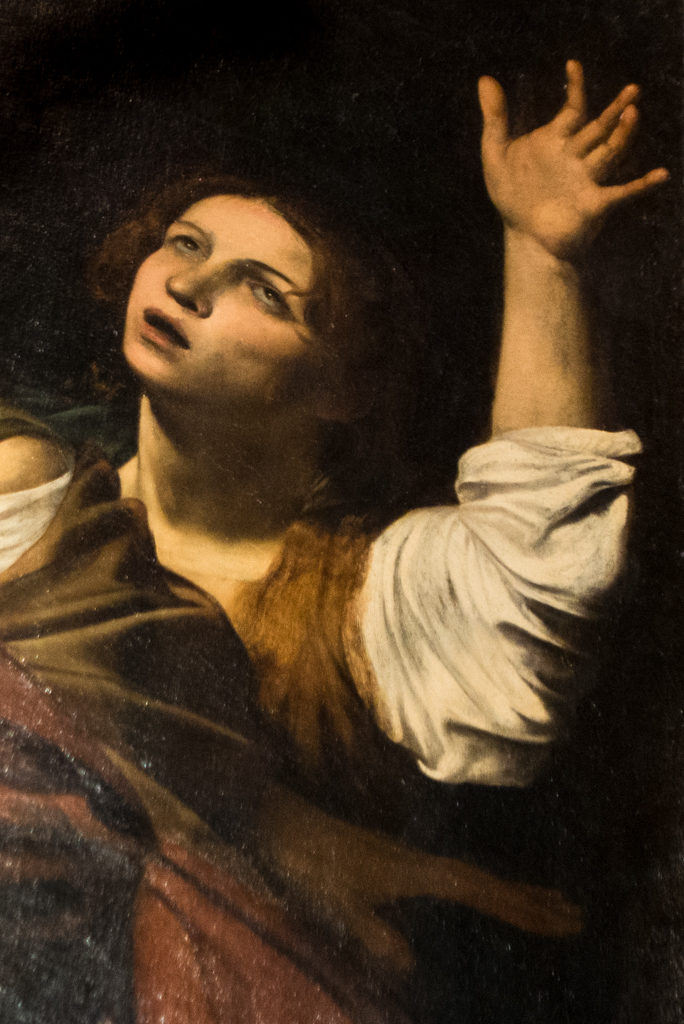
An old man lies on the floor. He lifts an imploring hand towards his attacker, a barely dressed young man about to deliver the final blow with a slender rapier. A little boy screams in horror. Silenzio, per favore! a voice echoes through the gloomy Contarelli Chapel. People push and shove to catch a good glimpse of the drama unfolding in front of their eyes. From the back of the nine-square-meter canvas a saddened young man gazes back at the crowd. It’s the painter himself, a convicted murderer. Then the light goes dark.
500 years ago, in October 1517, the Augustinian monk Martin Luther set off the Protestant Reformation. The church, he declared, had turned into a self-serving system of greed, nepotism and decadence. From now on, he demanded, Christians should have faith in God and the Bible alone, and not in angels and saints, nor in Virgin Mary and least of all the Pope.
The Catholic Church in Rome struck back, first in arms – they kicked off the bloodthirsty thirty year – then in arts. During the Council of Trent (held from 1545-63) they meticulously planned a propaganda campaign to trump Martin Luther’s thesis. Then they called for artists to vamp up the Eternal City, create buildings, fountains and staircases, paintings and sculptures so beautiful, so formidable and awe-inspiring they’d resurrect faith in angels, saints and Virgin Mary, and most of all the Pope. But also, they should instill fear into an illiterate people. And so Baroque Art was born.
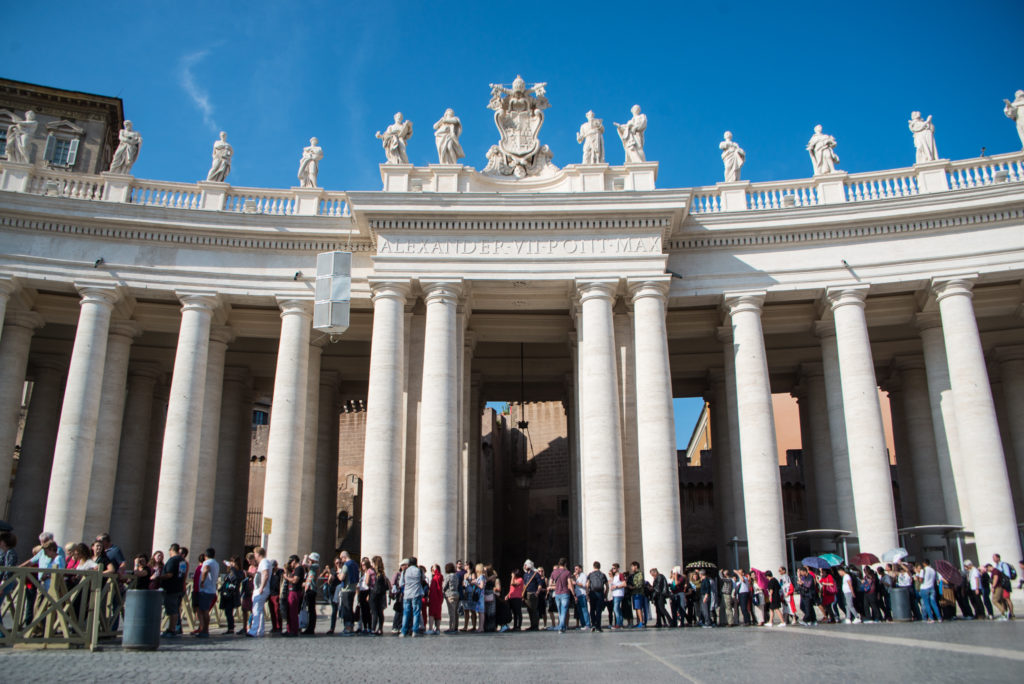
Among the artists enlisted by the church was a painter from Lombardy named Michelangelo Merisi, known as Caravaggio. His paintings were of unmatched intensity, realism and drama. This short itinerary through Baroque Rome, visiting his paintings in the splendid villas, churches and palaces, will reveal the historic truth behind Baroque, and shed a light on his dramatic life. For while the Counter Reformation turned out a huge success for the Pope, and Rome turned into a mesmerizing beauty, things did not go so smooth for the notorious artista maledetto.
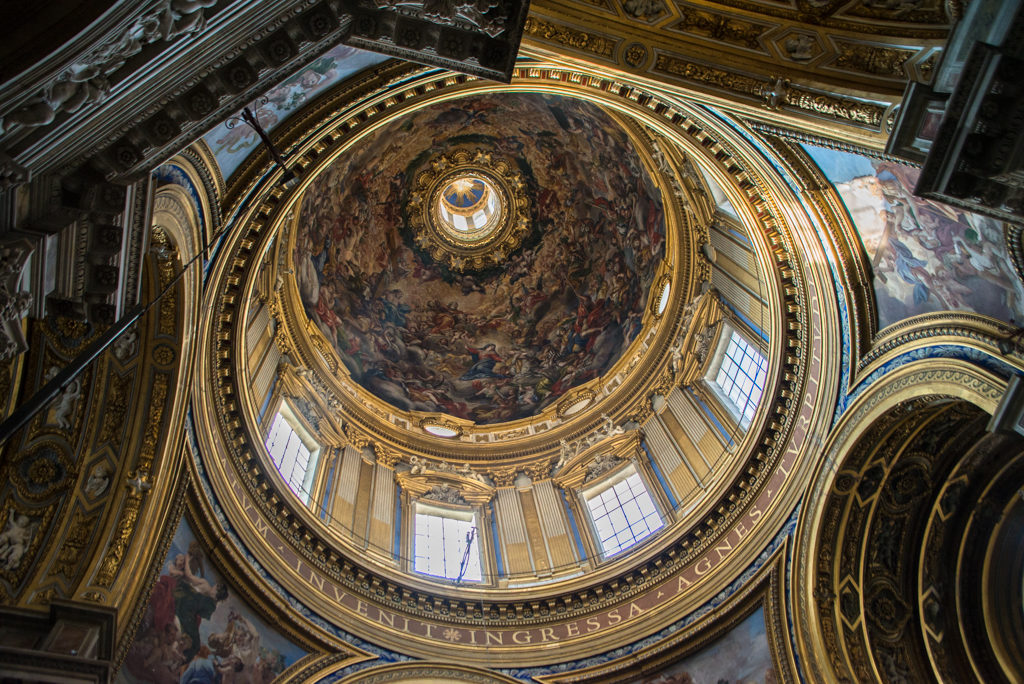
The Mean Streets of Tridente
The streets have not changed much in Tridente neighborhood, Rome’s artist quarter, when twenty year old Caravaggio arrived. The evening sun bounces off the cobble stones in eerie flashes of light. These streets are haunted. By night, the ghosts of those decapitated on the papal scaffold wander around, carrying their heads in their arms. Back in 1591, the whole of Rome was part of the Papal State, and the Pope and his cardinals ruled like absolute monarchs.
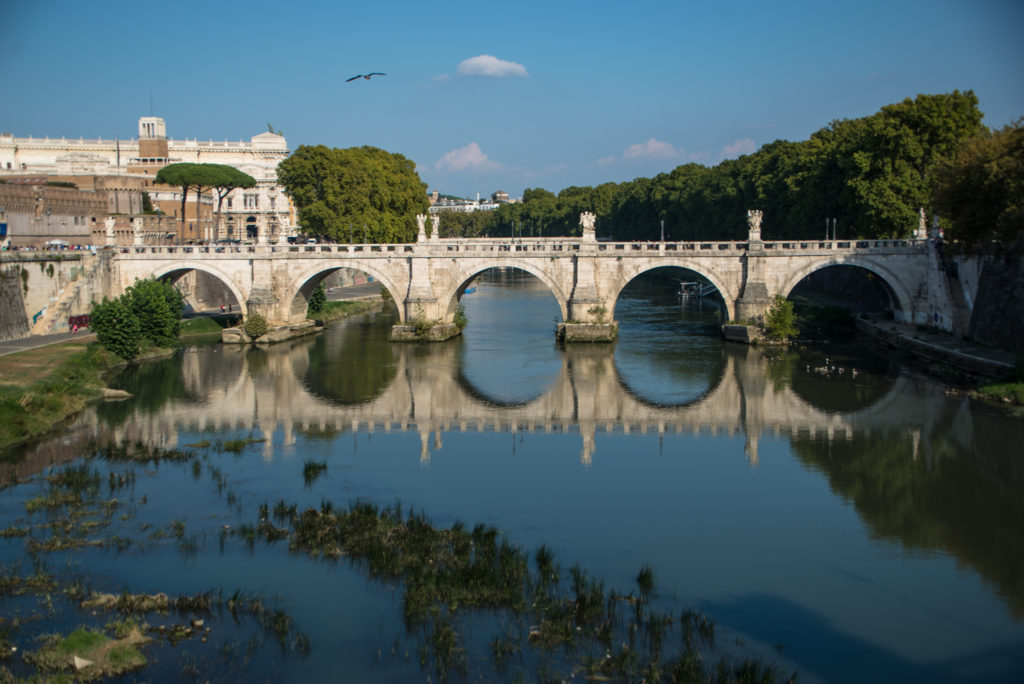
It’s hard to imagine the poverty and hardship today, among of chic shoppers and the white-shirted waiters shouting: “Pasta! Pizza!” with every procession of selfie stick toting tourists. Yet, while the world’s biggest church was erected – St. Peter’s Basilica – and glittering cupolas sprouted like mushrooms, famines ravaged. Brutal gangs held the streets in a tight grip. Those who could fled the city: The wealthy built their villas in the outskirts. Villas that needed to be filled with art.
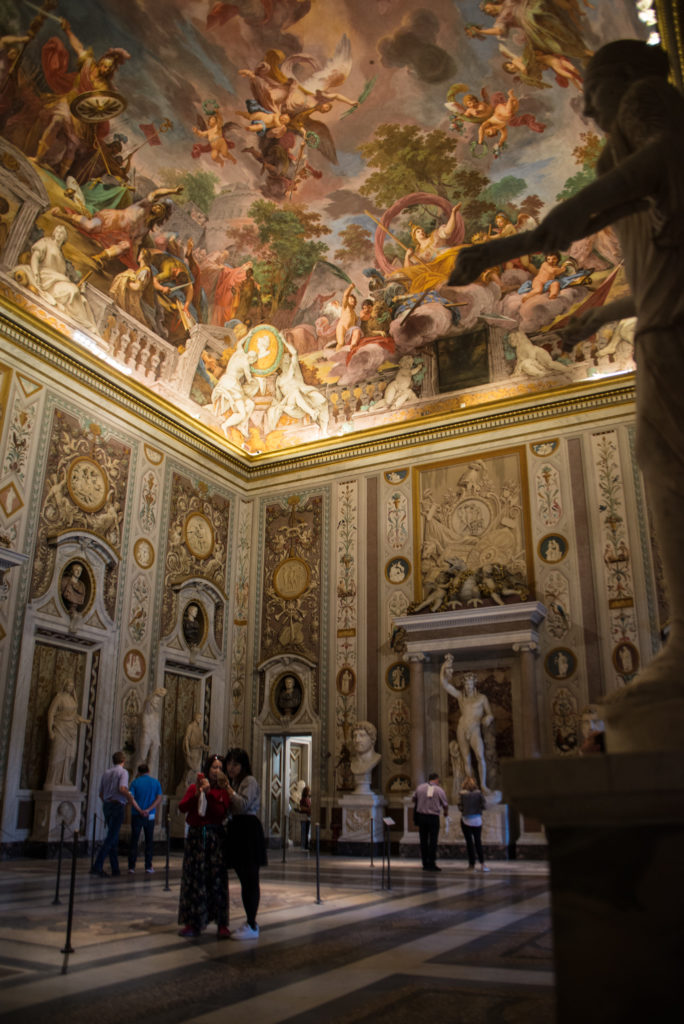
Villa Borghese: A Selfie For The Cardinal
The uphill walk towards Villa Borghese leads along graveled paths through the lavish Borghese Gardens. Fountains and statues stand scattered, forgotten almost among the tall planes and oaks. The swooshing of the trees in the breeze and the crunching of the gravels are the only sounds – if it weren’t for the cheery chatter of the apple-green parakeets in the tree tops. Like winged, emerald cherubs they add the final touch to these baroque gardens. Back when Caravaggio took on his first job in the Workshop Of Giant Heads, where he was to paint commercial still lives, they weren’t around. The Monk Parakeets only immigrated to Rome in the 1970ies.
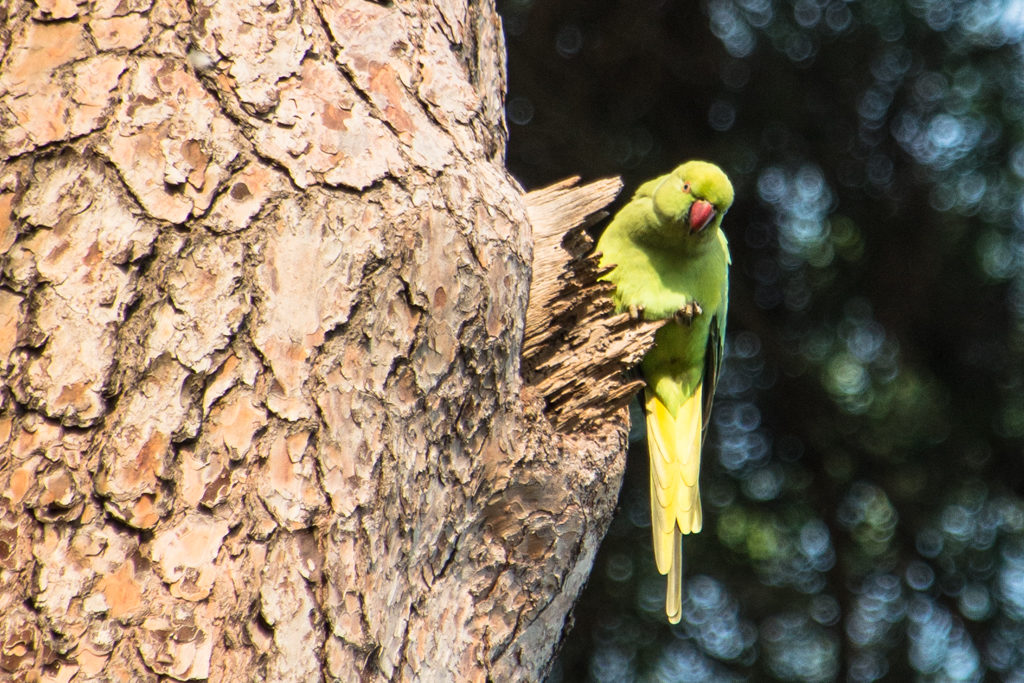
Villa Borghese, built around 1600 for the pope’s nephew, Cardinal Scipione Borghese, bedazzles with its golden stucco and vibrant frescos – and its prestigious collection of Baroque Art.
Caravaggio coyly nibbles on a hand of grapes. His black locks are adorned with a laurel wreath, his bare skin glows greenish. At 22, he portrayed himself as Bacchus, a sick Bachus however. The starving artist could afford neither a model, nor a doctor to treat his illness, the Roman Fever, most likely Malaria. It was only by 1962 when the Tiber was finally regulated and the marshes dried out that Rome became Malaria-free.
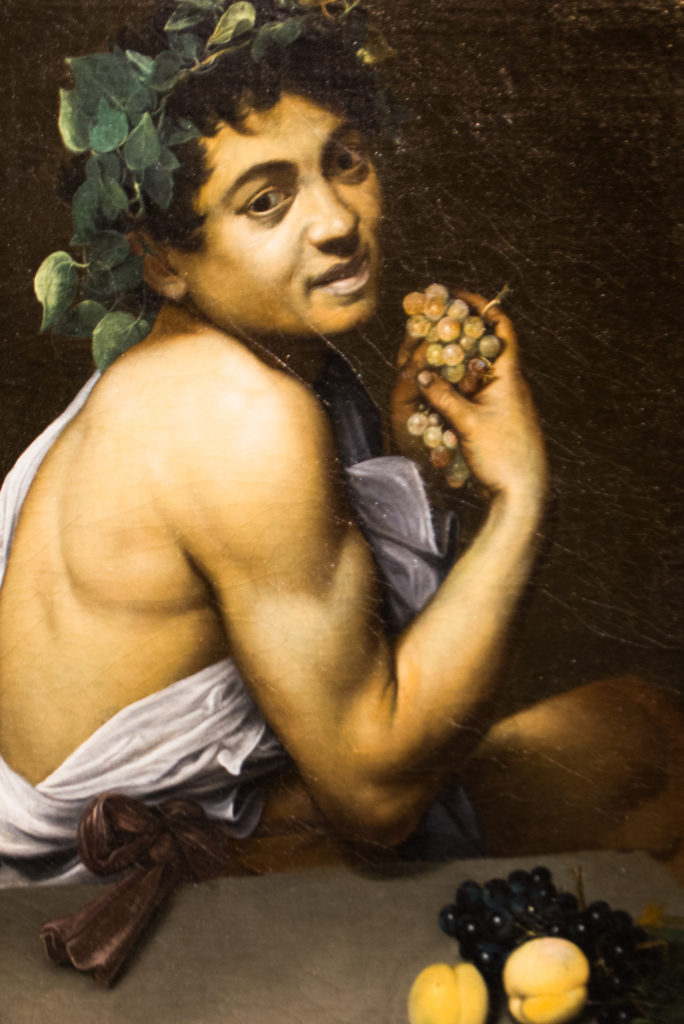
The grapes in his hand look extremely realistic. No other painter made fruit look as moist, as delicious – as tempting as the boy on the next painting. Clutching a basket of fruit, the juvenile flashes a bare shoulder and throws back his head, lips slightly parted. The boy, like most of Caravaggio’s models, was said to have “laid with him”.
While Caravaggio’s sexual orientation ignites passionate debates among art historians, Cardinal Borghese, an admirer of Caravaggio, could act openly on his homosexuality. The clergy’s sexual predilections were well known. Il Puttanismo Romano, Gregorio Leti’s satirical text about the sexual habits of high prelates, was published in the 1650ies – anonymously, of course. For lesser mortals, however, sodomy was regarded a mortal sin and punished by burning at the stake, alive. Without his friends in high places, Caravaggio’s racy still-lives would have sent him straight to hell.
Yet, Caravaggio apparently also leaned towards women. A few years later, he would kill for one: the well- known courtesan Fillide Melandroni, his model and presumed lover.
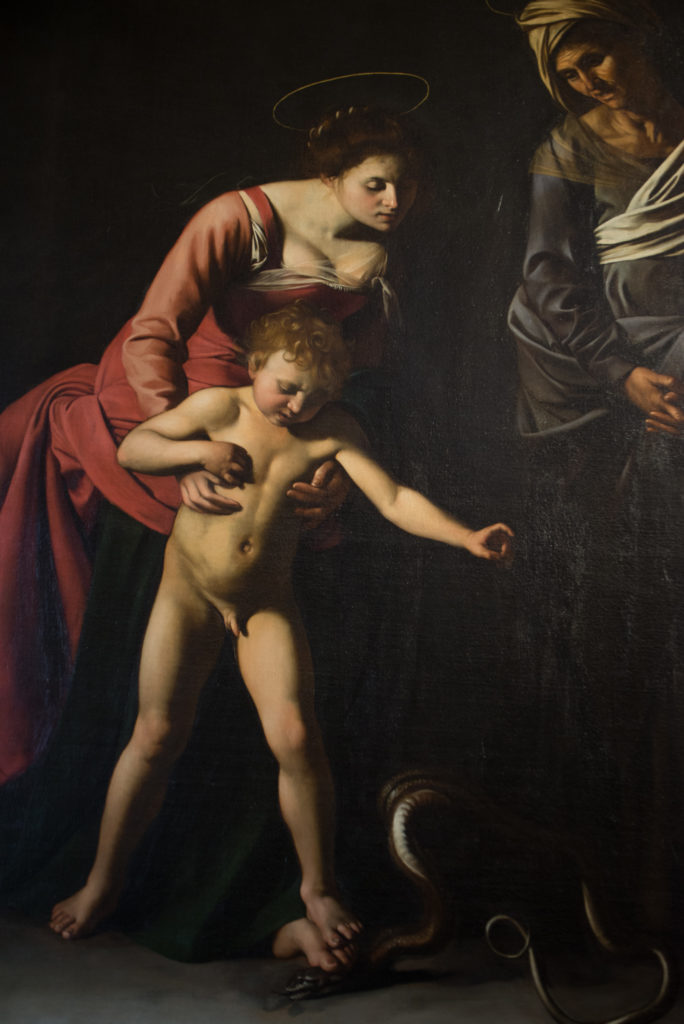
The Madonna dei Palafrenieri dates from 1605, when Caravaggio was already a superstar. The church commissioned him to paint Virgin Mary for St. Peter’s basilica. Caravaggio’s Madonna is set against a black backdrop. She shines brightly in the dark, a voluptuous woman, her cleavage generous as she bends to protect her son, naked Jesus, from a snake. She is not chaste and devout, as the cardinals had envisioned the immaculate virgin, but as fleshly and real as the women of the artist quarter – even her toe nails are black-rimmed from the soiled streets. The painting was taken down from St. Peter’s immediately.
“His compositions are fascinating,” Alexandra Hellman, a tourist from Sweden, remarks as she meanders through Galleria Borghese. “This darkness is like an abyss the characters steer towards, inevitably.”
David with the Head of Goliath from 1609 is another self-portrait. David’s naked, boyish torso and serious face are only partly revealed in the blackness. Caravaggio glares in pain, aged beyond measure. It is him, the severed head dangling from David’s hand.
In 1606 Caravaggio was sentenced to death by beheading. He fled Rome and sent this painting to Cardinal Borghese to solicit the pope’s to pardon. It was Caravaggio’s last.
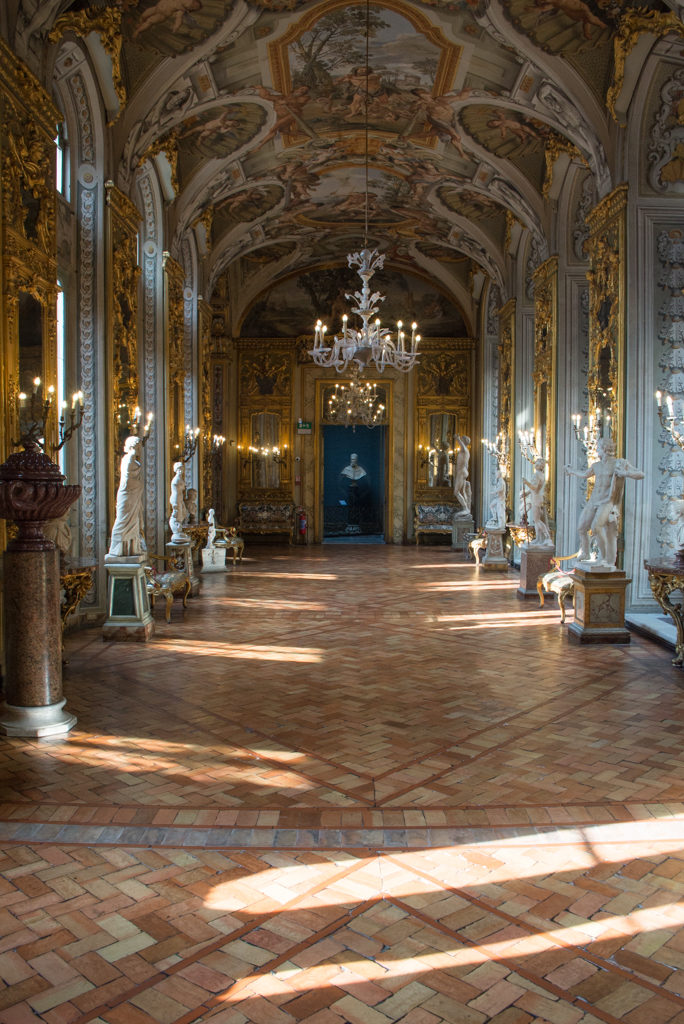
Palazzo Doria Pamphilj: No Hope, No Fear
A thirty minute walk down Via dei Corsi leads back to city life – the Mediterranean concerto of church bells and car honks, of pigeon coos and seagull shrieks – and into the dusty silence of Palazzo Doria Pamphilj.
Once the residence of dreaded Pope Innocent X and his lover and sister-in-law Pimpaccia, it appears to have fallen asleep long time ago. Chandeliers suspended from the high ceilings cast shadows on the statues and paintings that align the gloomy hallways. In the still ballroom, mannequins in baroque garments hold lyres and tambourines in their lifeless hands. There is a too much of everything in the Palazzo: of mirrors multiplying and warping the pale faces of marble statues, of reds and golds stucco, of heavy, suffocating ornaments. Innocent X and Pimpaccia were greedy people.
Caravaggio’s two paintings are relegated to a dim backroom, where all four walls are tapestried with oil paintings to the last square-centimeter. Both feature the real life courtesan Anna Bianchini, one as Penitent Mary Magdalene, the biblical courtesan. She sits with her eyes closed, her hands held tight, lost in sleep or prayer, lost to the world. Pearls lay scattered by her side. She must have broken her chain of pearls. The courtesan appears fragile, contrite. A few years later Caravaggio will find himself as penitent.
Caravaggio killed a man, but by mistake. He only wanted to cut off the testicles of Ranuccio Tomassoni, but the poor man bled to death. Genital, as well as facial mutilations, were the currency of the gangs of Rome, and Caravaggio was a gangster – like many painters. His gang lived by the motto: nec spe, ne metu – no hope, no fear.
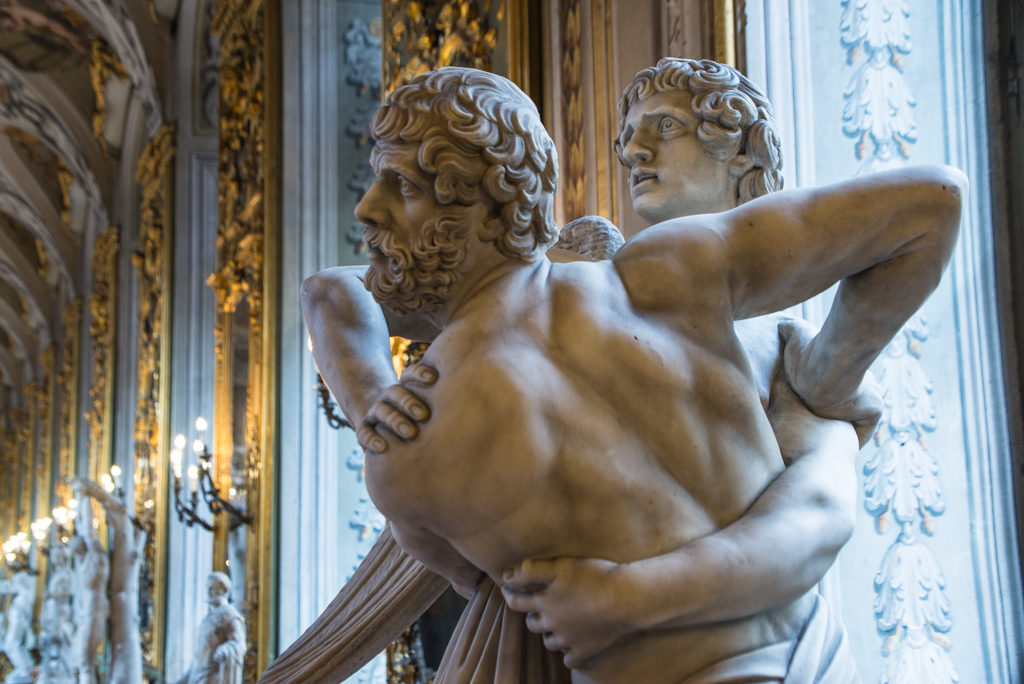
In fact, Caravaggio’s life can be traced back in police records. He carried weapons without permission: swords and daggers, a pistol even. He threatened people. He hurled a plate of fried artichokes into a waiter’s face and insulted his landlady after slashing a hole in the ceiling of his room. His paintings didn’t fit in.
Despite his success with the cardinals, Caravaggio preferred the company of the prostitutes, the beggars, the rent boys, who he used as models for the saints, the angels and Virgin Mary. In his extreme style of hard light and contrast, he elevated their ragged clothes, their soiled soles and black rimmed nails into signs of nobility. He turned vice into virtue.
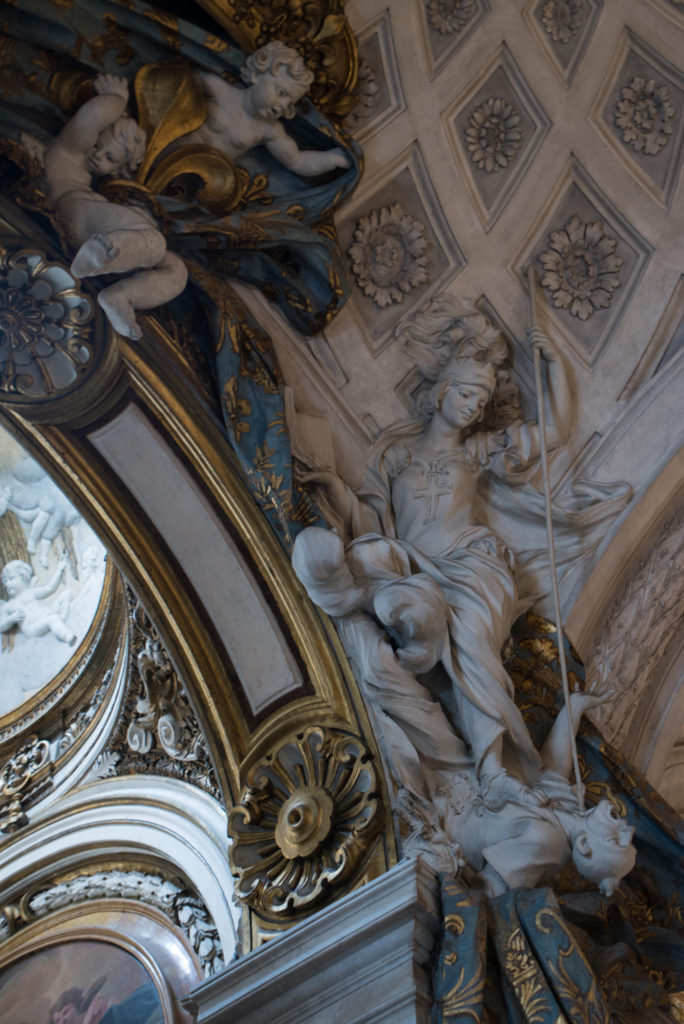
The Camera Obscura Of Cardinal Del Monte
From the rooftop terrace of the Pinacoteca Capitolina Rome is laid out in an orange sea of shingles and cupolas. Il Monte Capitolino, the Capitoline hill, where Rome was founded, was the ancient city’s sacred center.
On the second floor St. Paul the Baptist is smiling. He rests naked on a fur as he embraces a horny ram. Cardinal del Monte must have loved this painting, from what has transpired of his spicy dinner parties. It was however the neighboring painting, The Fortune Teller, a street scene from Caravaggio’s earliest, hunger-stricken days in Rome, which led him to Caravaggio. On the painting, a young, innocent man gets robbed his ring during a hand reading. The artist had sold the painting for the indecorously low sum of eight scudi to a noble man. When the Cardinal saw the painting at the noble man’s house, he was instantly enamored. He took Caravaggio into his household at Palazzo Madama and commissioned more than forty paintings.
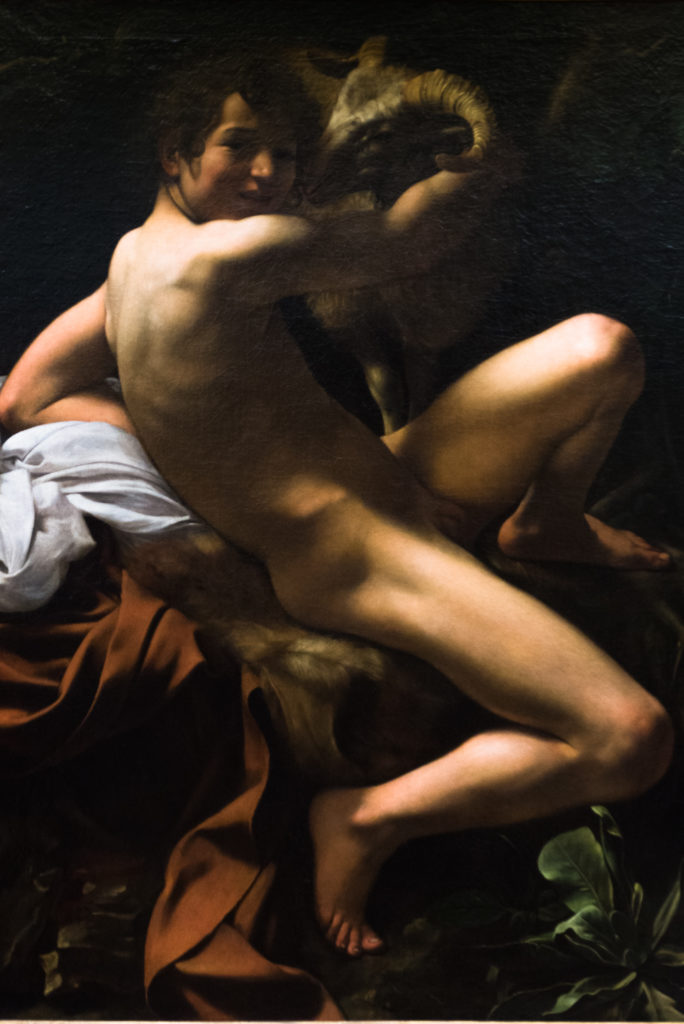
Cardinal del Monte was also an alchemist and friends with the scientist Gianbattista della Porta who had constructed a camera obscura. Soon questions were asked: How could Caravaggio paint so many paintings in so little time if he did not even have a workshop like other painters? How could he paint so realistically? Why, disapproving art historians wondered, were there never any pencil sketches found?
Other than a theoretical possibility, there is no evidence that Caravaggio ever used a camera obscura, the precursor of the modern photo-camera. But if he did, he played with fire. The church knew no merci. In 1600 Giordano Bruno was publicly burned at the stake. Not for sodomy, but for science.
The church is in Ecstasy and Caravaggio is Rome
It was thanks to Cardinal Del Monte that Caravaggio was commissioned by the Vatican to paint biblical scenes – scenes full of drama and passion, yet without full busted women and stark-naked boys.
The Counter Reformation had outlawed any worldly pleasures. Art should act as a surrogate. By decree, painters were to depict realistic scenes of divine rapture in a most emotional, dynamic and physically expressive way. As a moment of Ex Stasis: the brief out-of-body experience of heavenly joy and divine union. The little death in the face of the Saints and Angels, the divinely human. The domain of Caravaggio.
With his paintings in the churches finally at public display, Caravaggio instantly turned into a superstar. People flocked to see his paintings, mesmerized by the drama. Painters from all over Europe came to studio his technique.
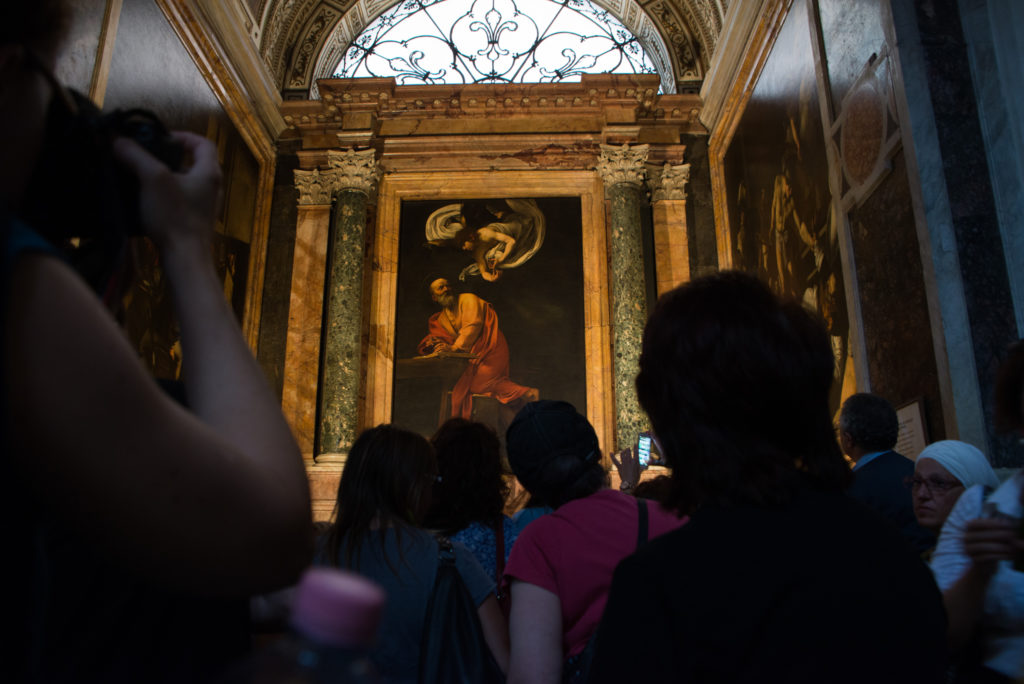
Hexi Shi from China inserts a coin into the little box at Contarelli Chapel and the light goes back on. The old man is still on the floor, the boy screaming in horror. The Martyrdom of St. Mathew dates from 1600. Caravaggio is still looking at us.
“Caravaggio’s works are not complicated for the onlooker,” Shi explains, “The prototypical 45 degree lighting, the contrast of the vibrant chiaroscuro, the perspective, and snapshots of dramatic moments are relatively easy to capture. If you look closely, the strokes and the contours can be very rough and seemingly careless, yet they add to an overall realistic effect“.
Shi has not come to Rome to paint – he is a scientist – but once exposed to the paintings of Caravaggio he became enthralled and picked up the brush.
“I imagine Caravaggio like a modern day Romano: short-tempered, straight-forward and fierce, yet with a passion for precision and detail, like making pasta,” he says. “Caravaggio is for Rome, and Rome for Caravaggio.”
Palazzo Barberini: A Game Of Tennis
Elegant Palazzo Barberini is just by the Dolce Vita of Trevi Fountain. Its masterly designed interior, its helicoidal staircase from 1633 is mesmerizing. Or dizzying. Or both.
Judith seems both fascinated and appalled as she cuts off Holofernes’ head. The story of the Jewish widow decapitating the hostile general was a popular motif. In the bible it was meant as an allegory – the end justifies the means – but Caravaggio made the strain and pain palpable, the suffering real. He rendered allegory human.
Again it was Caravaggio’s sensual depiction of a biblical woman that caused the scandal. The model was the courtesan Fillide Melandroni. She worked for Tomassini, the pimp.
No one knows why Caravaggio got into a fight with Tomassini. Jealousy? Money? Honor? On May 28 they met for a game of Tennis, or rather pallacorda, its old Italian version, in Via di Pallacorda, as the little lane in Tridente neighborhood is still called. Caravaggio won. Then he pulled the sword.
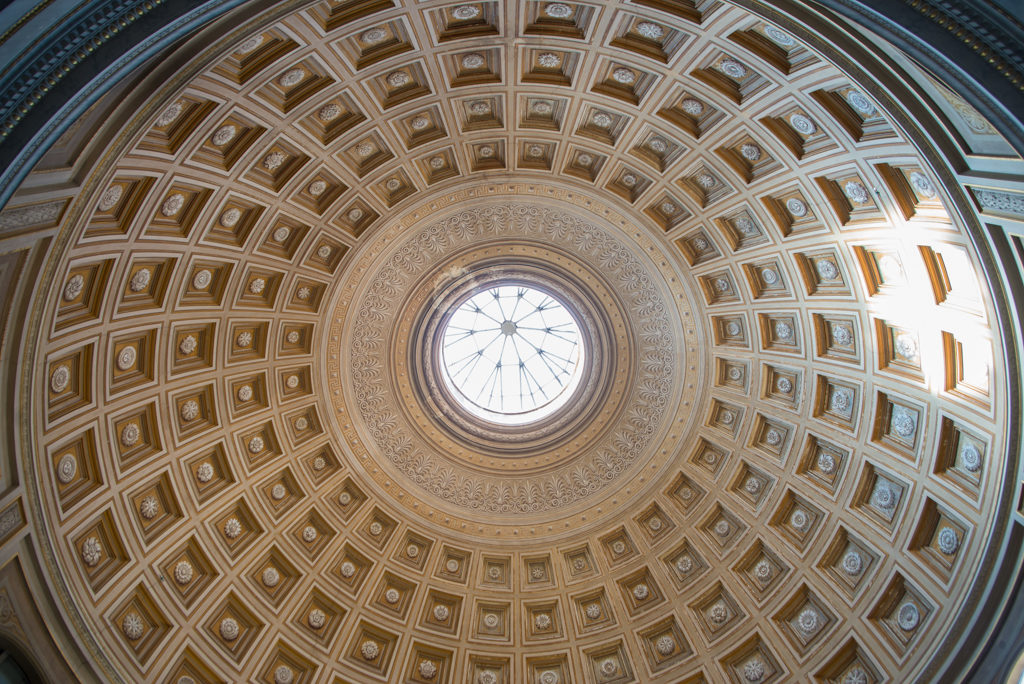
As a murderer no cardinal could help him. Panic-stricken he fled. After six years on the run, at 39, Caravaggio died. His faced had been mutilated – by who no one knows, another brawl? An act of revenge? He had been on his way back to Rome. The pope had pardoned him.
400 years later, Caravaggio still draws the masses. In his paintings we still recognize ourselves. Maybe a trip to baroque Rome reveals an eternal truth. Like: We are made of dark and light. Or: Life is but a game of tennis, a counter to a strike. Caravaggio was religiously devoted – to his reality. It’s still relevant. The kids in the streets are angels, if we see them as such.
